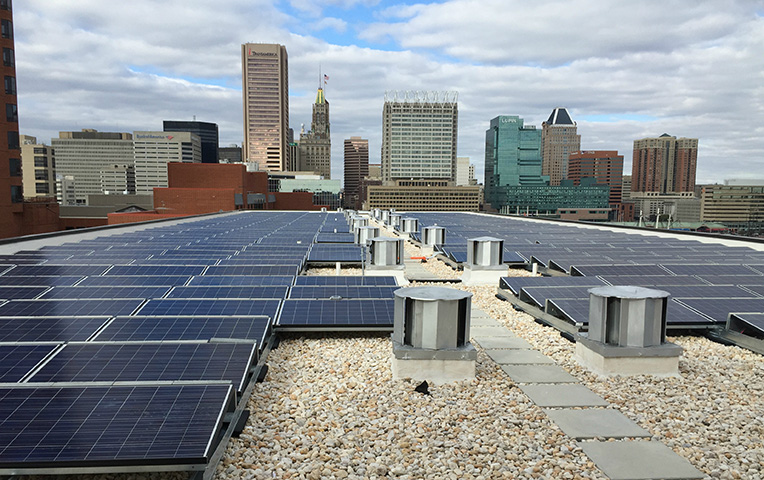On April 8th, 2019 the Maryland General Assembly passed the Clean Energy Jobs Act (CEJA), an update to the state’s renewable portfolio standard. The bill raises the state’s renewable goal to 50% by 2030 with a 14.5% solar carve-out. This increases 2019 demand for SRECs from 1.95% to 5.5%.
SREC Prices on the Rise
As stated in The SOURCE earlier this year, to meet the 14.5% solar carve-out, based on current load, 5 GW of solar will need to be built. This increased demand under Maryland’s RPS has already begun sending market signals and translated into a major increase in state SREC prices. Before CEJA was passed, SRECs in Maryland were trading around $11; however, post CEJA becoming law we’ve seen SREC pricing rise as high as $74. CEJA has provided much needed price support to Maryland’s SREC market. However, we’ll likely never see it go back up to its 2016 high of $160 given that the alternative compliance payment, the effective price ceiling for the market, is set at $100. Even with the $100 cap, the higher SREC prices will create a stronger incentive for Maryland residents and business owners to install solar, helping the economy and the environment. This effect can be seen through the original introduction of the SREC program, which helped to establish Maryland as an early leader in residential solar. A similar effect could be expected from CEJA’s expansion of the program.
This renewed and increased demand for solar will help reinvigorate the solar industry in the state bring more solar jobs back to Maryland, which saw a decrease of over 900 jobs with the lull in the SREC market under previous legislation. According to the Solar Foundation’s Jobs Census, Maryland has lost about one thousand solar jobs in the last two years. The state of Maryland has already released projections from 2018 that anticipate that there will be over one thousand new electricians and related professionals in the state by 2020, many of which may be able to install solar.
Legislative Resistance
While CEJA was ultimately successful and faced some opposition from the legislature, the biggest unknown was how Governor Hogan would react. Governor Hogan who does support renewable development and acknowledges the dangers our natural environment is facing, has not been a supporter of the state’s RPS. In the end, CEJA passed the General Assembly with a veto-proof majority, showing strong support from the legislative branch, and Governor Hogan let the bill pass without his signature, allowing it to go into effect on May 25th, 2019. In his statement on why he did not sign the bill, Governor Hogan wrote that the “bill is not clean enough, nor smart enough, nor does it create the intended jobs within Maryland” and that he plans on introducing his own legislation on the first day of the 2020 legislative session. It is yet to be seen what impacts Governor Hogan’s potential Clean and Renewable Energy Standard (CARES) on the broader RPS and on the solar carve-out since he hasn’t yet provided specifics, but the solar industry will continue to monitor, engage, and advocate for strong solar policy in Maryland.
Positive Steps Towards Greater Maryland Solar Build-out
CEJA wasn’t the only pro-solar bill that passed in Annapolis this session. Two other bills that passed alongside CEJA have the potential to increase installation rates in Maryland by making solar an even more enticing investment. The first was a bill that extended the state's community solar program until 2022 and increased maximum capacity of program systems to 2 MW. The other bill created an energy storage pilot program requiring utilities to facilitate the building of 10 MW of energy storage. These new pieces of legislation should compound to create an increase in the amount of solar installed in the state over the next ten years.
This legislative session, the state of Maryland has continued to set higher and more ambitious goals, which should act to bolster the SREC and solar markets. The Assembly’s expansion of the RPS and solar carve-out have already helped to create more demand in an over supplied Maryland SREC market. Even though SREC prices will never again reach their 2016 highs, there is still a lot of room for growth in both the SREC and wider solar market. This bill also does not mark the last potential RPS expansion for the state of Maryland. CEJA included a provision for the General Assembly to review the standard and assess the feasibility of a 100% goal by 2040, but that will have to wait until around 2025.
ABOUT SOL SYSTEMS
Sol Systems, a national solar finance and development firm, delivers sophisticated, customized services for institutional, corporate, and municipal customers. Sol is employee-owned, and has been profitable since inception in 2008. Sol is backed by Sempra Energy, a $25+ billion energy company.
Over the last ten years, Sol Systems has delivered 800 MW of solar projects for Fortune 100 companies, municipalities, universities, churches, and small businesses. Sol now manages over $650 million in solar energy assets for utilities, banks, and Fortune 500 companies.
Inc. 5000 recognized Sol Systems in its annual list of the nation’s fastest-growing private companies for four consecutive years. For more information, please visit www.solsystems.com



